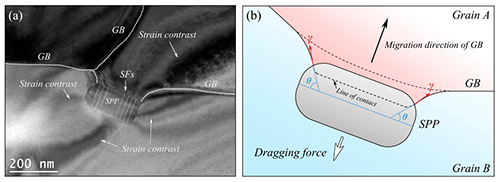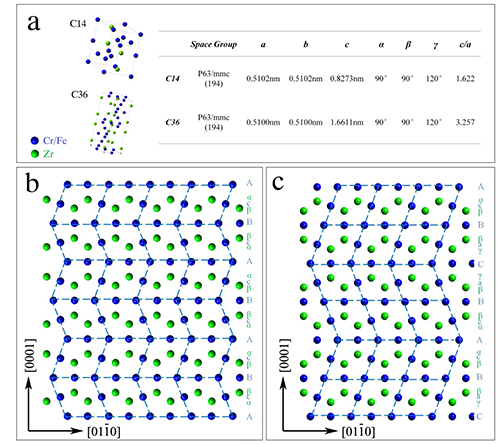A stacking fault exists when two adjacent atomic planes are not in their proper crystallographic registry. As defects in crystals, stacking faults are frequently observed both in metals and intermetallics. Laves phase, which is one of the most commonly observed intermetallics, can have one of three related structures, corresponding to C15-cubic, C14-hexagonal and C36-hexaghgonal structures, respectively.
In Zircaloy-4 (Zr-4) alloy, local enrichment of alloying elements which originally dissolved in the matrix often lead to precipitation of secondary phase particles (SPP) with Laves phase structure, which play an important role in strengthening and improving the corrosion resistance of the Zr-4 alloy. The crystal structure of SPP in Zr-4 alloy was widely investigated. Fe and Cr enriched SPP had been identified as Zr(Fe,Cr)2 Laves phase with either C15-cubic or C14-hexagonal structure.
Professor LI Geping’s group from the Institute of Metal Research, Chinese Academy of Sciences (IMR, CAS) recently discovered that the C14 structured Laves phase SPP often contain stacking faults. In addition, it was indicated that the SFs in the C14 structured SPP actually existed as local C36 structured Laves phase, for their similarities in crystallography. The C14→C36 phase transformation, which was driven by synchroshearing among (0001) basal planes, was the formation mechanism of the stacking faults in the SPPs. By analyzing the strained regions near the SPP, a model for understanding the driving force of the synchroshear was proposed: The interaction between SPP and GB resulted in the Zener Pinning effect, leading to the shearing parallel to the (0001) basal planes of the C14 structured SPP, and the synchroshear was therefore activated. As there are similar stacking sequences in C15 and C14 structures, our model may be applied for understanding the stacking faults in C15 structured Laves phase, which was also frequently observed.
The phase transformation caused by interaction between GB and SPP, based on our theory, brings a new way of thinking, contributing to grain boundary engineering with particles, or to improve the ductility of metallic compounds.
The study entitled ‘Stacking faults in Zr(Fe,Cr)2 Laves structured secondary phase particle in Zircaloy-4 alloy’ has been published in the journal Nanoscale.

Fig.1 The interaction between Secondary phase particle (SPP) and grain boundary (GB). (a) BF TEM image of the SPP and the nearby GBs. (b) A schematic image showing the interaction between the SPP and GB, resulting in the dragging force perpendicular to the original GB. (Image by IMR)

Fig.2 Crystallographic data of the C14 and C36 structure. (a) Unit cell and lattice parameters of the C14 and C36 structure, correspondingly. (b) Model of the C14 structure viewed along [2 0] direction. The stacking of the [0001] planes is marked by different letters. (c) Model of the C36 structure viewed along [2 0] direction. The stacking of the [0001] planes is marked by different letters. (Image by IMR)